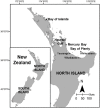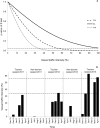Behavioural effects of tourism on oceanic common dolphins, Delphinus sp., in New Zealand: the effects of Markov analysis variations and current tour operator compliance with regulations
- PMID: 25565523
- PMCID: PMC4286237
- DOI: 10.1371/journal.pone.0116962
Behavioural effects of tourism on oceanic common dolphins, Delphinus sp., in New Zealand: the effects of Markov analysis variations and current tour operator compliance with regulations
Abstract
Common dolphins, Delphinus sp., are one of the marine mammal species tourism operations in New Zealand focus on. While effects of cetacean-watching activities have previously been examined in coastal regions in New Zealand, this study is the first to investigate effects of commercial tourism and recreational vessels on common dolphins in an open oceanic habitat. Observations from both an independent research vessel and aboard commercial tour vessels operating off the central and east coast Bay of Plenty, North Island, New Zealand were used to assess dolphin behaviour and record the level of compliance by permitted commercial tour operators and private recreational vessels with New Zealand regulations. Dolphin behaviour was assessed using two different approaches to Markov chain analysis in order to examine variation of responses of dolphins to vessels. Results showed that, regardless of the variance in Markov methods, dolphin foraging behaviour was significantly altered by boat interactions. Dolphins spent less time foraging during interactions and took significantly longer to return to foraging once disrupted by vessel presence. This research raises concerns about the potential disruption to feeding, a biologically critical behaviour. This may be particularly important in an open oceanic habitat, where prey resources are typically widely dispersed and unpredictable in abundance. Furthermore, because tourism in this region focuses on common dolphins transiting between adjacent coastal locations, the potential for cumulative effects could exacerbate the local effects demonstrated in this study. While the overall level of compliance by commercial operators was relatively high, non-compliance to the regulations was observed with time restriction, number or speed of vessels interacting with dolphins not being respected. Additionally, prohibited swimming with calves did occur. The effects shown in this study should be carefully considered within conservation management plans, in order to reduce the risk of detrimental effects on common dolphins within the region.
Conflict of interest statement
Figures




Similar articles
-
How does Australia's largest dolphin-watching industry affect the behaviour of a small and resident population of Indo-Pacific bottlenose dolphins?J Environ Manage. 2012 Apr 30;97:14-21. doi: 10.1016/j.jenvman.2011.11.002. Epub 2011 Dec 24. J Environ Manage. 2012. PMID: 22325578
-
Behavioural responses of dusky dolphin groups (Lagenorhynchus obscurus) to tour vessels off Kaikoura, New Zealand.PLoS One. 2012;7(7):e41969. doi: 10.1371/journal.pone.0041969. Epub 2012 Jul 23. PLoS One. 2012. PMID: 22844536 Free PMC article.
-
Decline in relative abundance of bottlenose dolphins exposed to long-term disturbance.Conserv Biol. 2006 Dec;20(6):1791-8. doi: 10.1111/j.1523-1739.2006.00540.x. Conserv Biol. 2006. PMID: 17181814
-
Effects of vessels on common dolphin activity patterns in a critical area for the species. Conservation implications.Mar Environ Res. 2025 May;207:107081. doi: 10.1016/j.marenvres.2025.107081. Epub 2025 Mar 15. Mar Environ Res. 2025. PMID: 40120423 Review.
-
The social structure and strategies of delphinids: predictions based on an ecological framework.Adv Mar Biol. 2007;53:195-294. doi: 10.1016/S0065-2881(07)53003-8. Adv Mar Biol. 2007. PMID: 17936137 Review.
Cited by
-
Chronic exposure of Hawaii Island spinner dolphins (Stenella longirostris) to human activities.R Soc Open Sci. 2018 Oct 24;5(10):171506. doi: 10.1098/rsos.171506. eCollection 2018 Oct. R Soc Open Sci. 2018. PMID: 30473795 Free PMC article.
-
Evaluating Potential Cetacean Welfare Indicators from Video of Live Stranded Long-Finned Pilot Whales (Globicephala melas edwardii).Animals (Basel). 2022 Jul 21;12(14):1861. doi: 10.3390/ani12141861. Animals (Basel). 2022. PMID: 35883407 Free PMC article.
-
Soundwatch: Eighteen years of monitoring whale watch vessel activities in the Salish Sea.PLoS One. 2017 Dec 22;12(12):e0189764. doi: 10.1371/journal.pone.0189764. eCollection 2017. PLoS One. 2017. PMID: 29272275 Free PMC article.
-
A computational formulation of the behavior systems account of the temporal organization of motivated behavior.Behav Processes. 2019 Dec;169:103952. doi: 10.1016/j.beproc.2019.103952. Epub 2019 Sep 20. Behav Processes. 2019. PMID: 31543283 Free PMC article. Review.
-
Assessment on the effectiveness of vessel-approach regulations to protect cetaceans in Australia: A review on behavioral impacts with case study on the threatened Burrunan dolphin (Tursiops australis).PLoS One. 2021 Jan 19;16(1):e0243353. doi: 10.1371/journal.pone.0243353. eCollection 2021. PLoS One. 2021. PMID: 33465088 Free PMC article. Review.
References
-
- Williams R, Bain DE, Smith JC, Lusseau D (2009) Effects of vessels on behaviour patterns of individual southern resident killer whales Orcinus orca . Endangered Species Research 6: 199–209. 10.3354/esr00150 - DOI
-
- Lusseau D (2004) The hidden cost of tourism: Detecting long-term effects of tourism using behavioral information. Ecology and Society 9: 2.
-
- Orams M (2004) Why dolphins may get ulcers: Considering the impacts of cetacean-based tourism in New Zealand. Tourism in Marine Environments 1: 17–28.
-
- Scarpaci C, Parsons ECM (2013) Recent advances in whale-watching research: 2012–2013. Journal of Cetacean Research and Management SC/65a/WW01: 1–18.
Publication types
MeSH terms
LinkOut - more resources
Full Text Sources
Other Literature Sources

